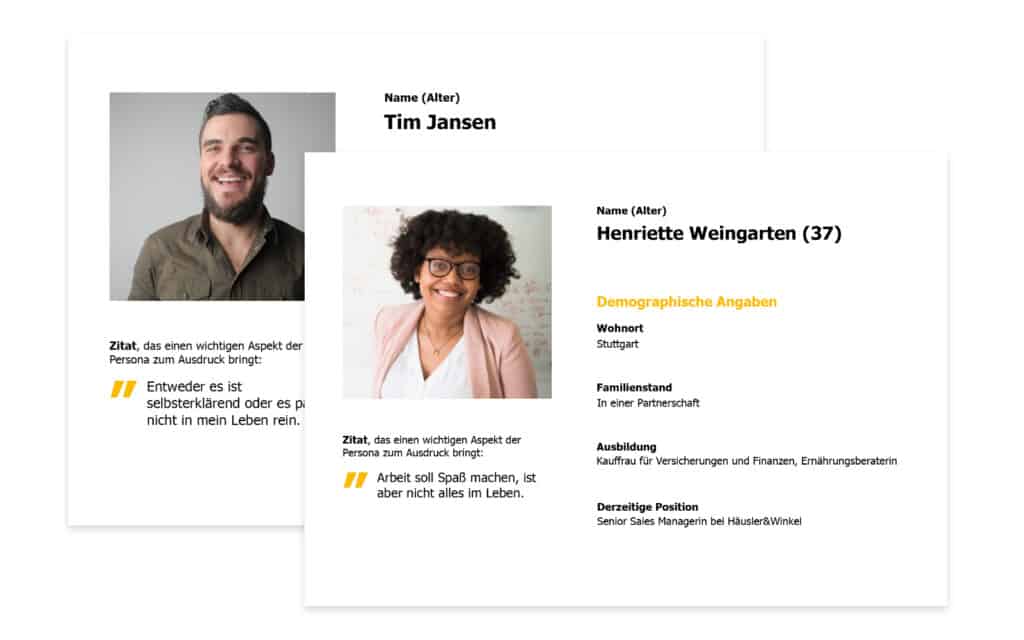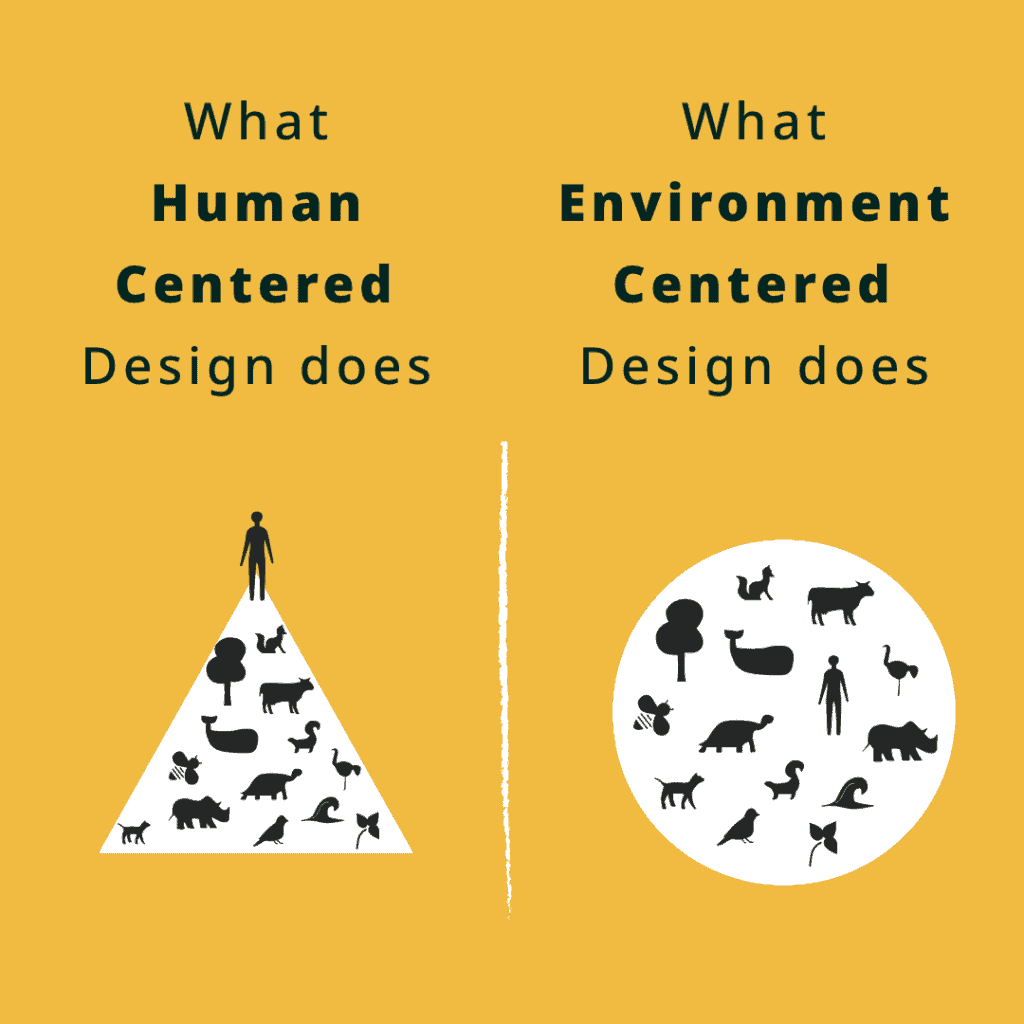Mother Nature as a Persona (incl. template)

You would like to understand the thoughts of users better? You want to know what they think, feel and what their goals are? At the same time, you want to include our environment – Mother Nature – in the design process? One of the best-known user research methods for building empathy are Personas. In this article, I’ll tell you what Personas are, what they aim to achieve and why Mother Nature in various forms as a Persona is good for green innovations, climate-friendly websites and sustainable services [1]. Including a template and examples.
What are Personas and what do they bring?
Personas are fictitious target persons, in a sense profiles of different target groups. They contain demographic information as well as goals, wishes, actions and feelings of hypothetical target persons. Therefore Personas are a systematic framework that helps to better understand users.
Personas are based on extensive research and (please, please) never on pure hypotheses. This only ends in wishful thinking and rarely in really useful assumptions and thus results. Therefore: Don’t think in stereotypes! Also, always question whether the scenario is realistic or whether it corresponds more to wishful thinking. The more real cases of users are known, the easier it is to develop a Persona.
The more the customer’s thoughts are understood, the better we can respond to them. With truly appropriate products and services. Personas help to emphasize, to take on the perspectives of the customers and to view them holistically. The best thing is that you get out of the internal perspective.

This is how Personas are ideally developed
- You know who the target group is.
- You observe the target group. You do research. You conduct interviews with real people. You ask questions. You analyse support requests and social media comments.
- You fill in the profiles of the Personas with initial hypotheses.
- You continue to observe, research and interview. The Personas “live” and all assumptions made are verified again and again (otherwise it is wishful thinking).
- You edit the Personas again and again.
- You introduce the Personas to other departments or teams working on the same project.
- The actual goal: You let the Personas flow into all design and decision-making processes. This way you can always remember for whom you are doing all this and what the exact needs of the customers are.
Before we get to the Environment Centered Personas: If you want to know more about the basics of the method, feel free to read my blog article on Personas at allcodesarebeautiful!
How does Mother Nature become a Persona?
Environment Centered Design
Environment Centered Design no longer focuses on the user or on people in general. Rather, each ecosystem is given equal consideration. A circle, instead of a pyramid. The way the world really is [3].

Environment Centered Personas
If we take this principle into the UX method of personas, we must not only consider humans as target persons, but must also consider non-human target groups as stakeholders in Environment Centered Personas.
What are these non-human stakeholders? Honestly, everything that surrounds you. Plants, animals, even our entire planet. All of them are directly or indirectly affected by your actions and projects. That’s why they have to be taken into account.
It is such an incredibly powerful eye-opener. For our nature. For the impact we have. And as I have experienced in myself, as well as in workshops on the topic – for unbelievably great innovations, ideas and solutions.
But how exactly does that look like?
Creation of Environment Centered Personas – with example and template
Grab my non-human Persona template and take one or two hours to go through the method.
Would you like to create the personas together with me? Then simply contact me for a workshop.
Step 1: Feel it
Forests, trees, streams, oceans, insects, mammals, bushes, bogs, mountains, valleys, rivers, fish, jungles, reptiles, corals, seasons – all these and so much more are part of our multi-layered nature. Feel free to close your eyes (yes, right now) and imagine Mother Nature. In all her fullness. With all its colours and shapes. With all the scents and sounds.
Need some inspiration? Watch this short and beautiful video about Mother Nature (click on the image to open YouTube).

Step 2: Define the non-human stakeholders for your project or business
Now imagine “Mother Nature” or part of the ecosystem as a Persona (without humanizing her too much). For sure, “Mother Nature” as a whole is affected by your project. But maybe additionally specifically the Atlantic Ocean, the Brazilian Rainforest, the river near you or the city you live in.
Who is directly or indirectly affected by your project or business? Write down all stakeholders first. You may sort some out again later.
Step 3: Research extensively and conduct interviews
I know: there is no way to conduct interviews with these non-human planet-centric Personas, but
- search the internet for real facts,
- interview scientists and environmentalists,
- go out and take a look at how the ecosystems behave.
Even with non-human Personas, don’t be tempted to fall into stereotypes and untruths. Research the real state of the respective ecosystems. Only then you can have a real positive impact on the environment.
Step 4: Create Environment Centered Personas with initial hypotheses
Now take my template and fill in all the details.
What does the Persona look like? What is her profession, her age, her most important characteristics? What does she need? What are her dreams? What are her goals?
Imagine a loving and caring relationship with nature.

Step 5: Further elaborate the Personas
Research and further verify your hypotheses about the Environment Centered Personas. Are there any changes since you first created the Persona? Are there any new insights into the needs of the non-human Persona? Are there methods to measure your impact more accurately?
Let the non-human Personas “live” and enjoy learning new things about Mother Nature.
Step 6: Integrate the Personas into the project and team
This is where the full magic unfolds!
The non-human Personas are created? Then work with them!
- Let everyone in the team know about the new Personas!
- Get more opinions and discuss in the team how the Personas can be used and extended.
- See how your perspective on the project and the business changes (it will automatically).
- Apply the Personas to all design processes – website, app, newsletter funnel, content, communications, marketing strategy and services.
- Let the Personas grow, live and develop.
Wherever possible, try to emphasize with “Mother Nature”. What would not only the users want, but also your environment. Wish for. Hope for. Talk about it with others and always find new perspectives.
And believe me: the perspective will change. And that is exactly the beauty of the Environment Centered Method. It makes us rethink. Automatically. Just like that.
Where Personas and Mother Nature have their limits
Personas are a great tool to get a feel for the needs and situations of different target groups. They are neither all-encompassing nor do they give you exact solutions. They “only” give you a feeling. But that is exactly what I find very helpful. This feeling helps enormously in decision-making. The stronger the feeling, the better the ideas.
But be careful! Don’t think in stereotypes and let the Personas live with real facts – even the non-human Personas. Leave your findings for a few days and then come back to the development process. The Persona will certainly change again and again. Especially the more you learn about the sustainability of the business.
And what can you take away from this?
Remember: It is not only about what users want, but also about what is really good, healthy and sustainable for users, business AND our environment.
Try different methods to gain more empathy for the human and non-human stakeholders. Don’t lose sight of the bigger picture and don’t get too hung up on purely hypothetical findings that have never been backed up with real evidence.
Let me know on LinkedIn or Instagram if you have used Personas before and what the persona with Mother Nature revealed to you. And feel free to share the post with colleagues, clients and employees!
Please write to me if you have ideas for developing the Environment Centered Personas method even further. I am super excited to see where the journey can go!
Have a wonderful week!
Sandy
You would like to create the Personas together with me or completely by me?
Feel free to ask me for a workshop or the creation of (Environment Centered) Personas. I would be happy to help you with this!
If you want to create the Personas yourself, grab my Miro non-human Persona template, my Figma non-human Persona template or my PDF non-human Persona template (1,1MB) and take an hour or two to work on it.
Further reading recommendations
- Monika Snezl Non-human persona
- Monika Snezl Actant Mapping Canvas
- Damien Lutz Holistic Design Toolkit
- Vincit Planet centric design
- Threebility Sustainable Business Model Canvas
Sources
[1] https://greentheweb.com/what-is-green-ux-ui-webdesign/
[2] https://allcodesarebeautiful.com/personas-erstellen-vorlage/
[4] https://www.youtube.com/watch?v=3eFDhIeAM6A

Hi, I’m Sandy, the author of this blog and a UX/UI Designer with 10+ years of experience. I founded Green the Web in 2019 to share my passion, ideas and vision of a sustainable web with change makers like you. Let’s connect on LinkedIn or on Instagram @greentheweb to discuss and share ideas.

Sign up for the newsletter
Get the latest green web hacks, business insights and news directly into your inbox. Usually sent once a month.

Sustainable best practices
Get inspired by lightweight, user-friendly, aesthetic and sustainable UX/UI designs of the web.

My favorite resources
Scroll through my favorite articles, studies, podcasts, talks, communities, books and tools on sustainable web design.



